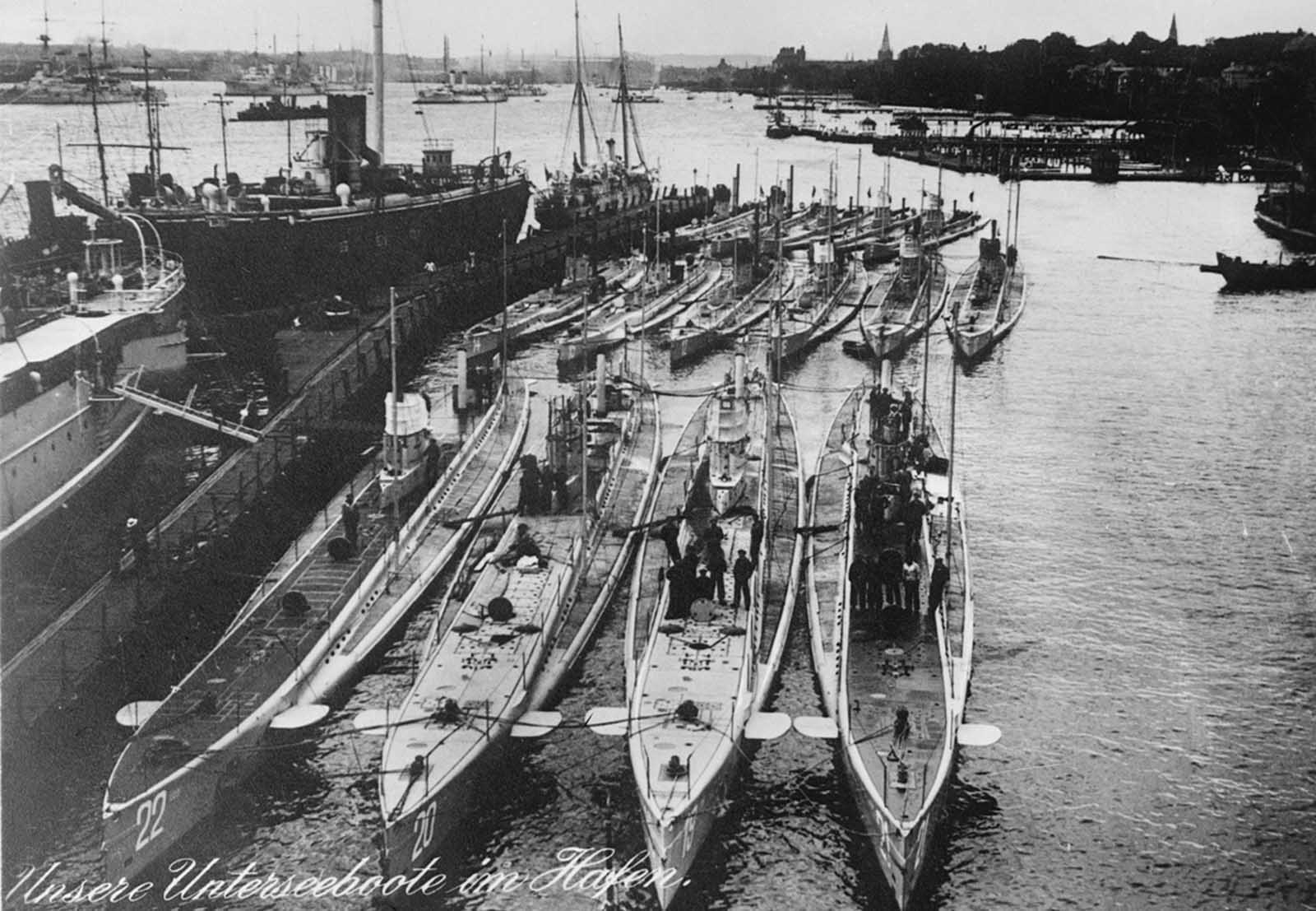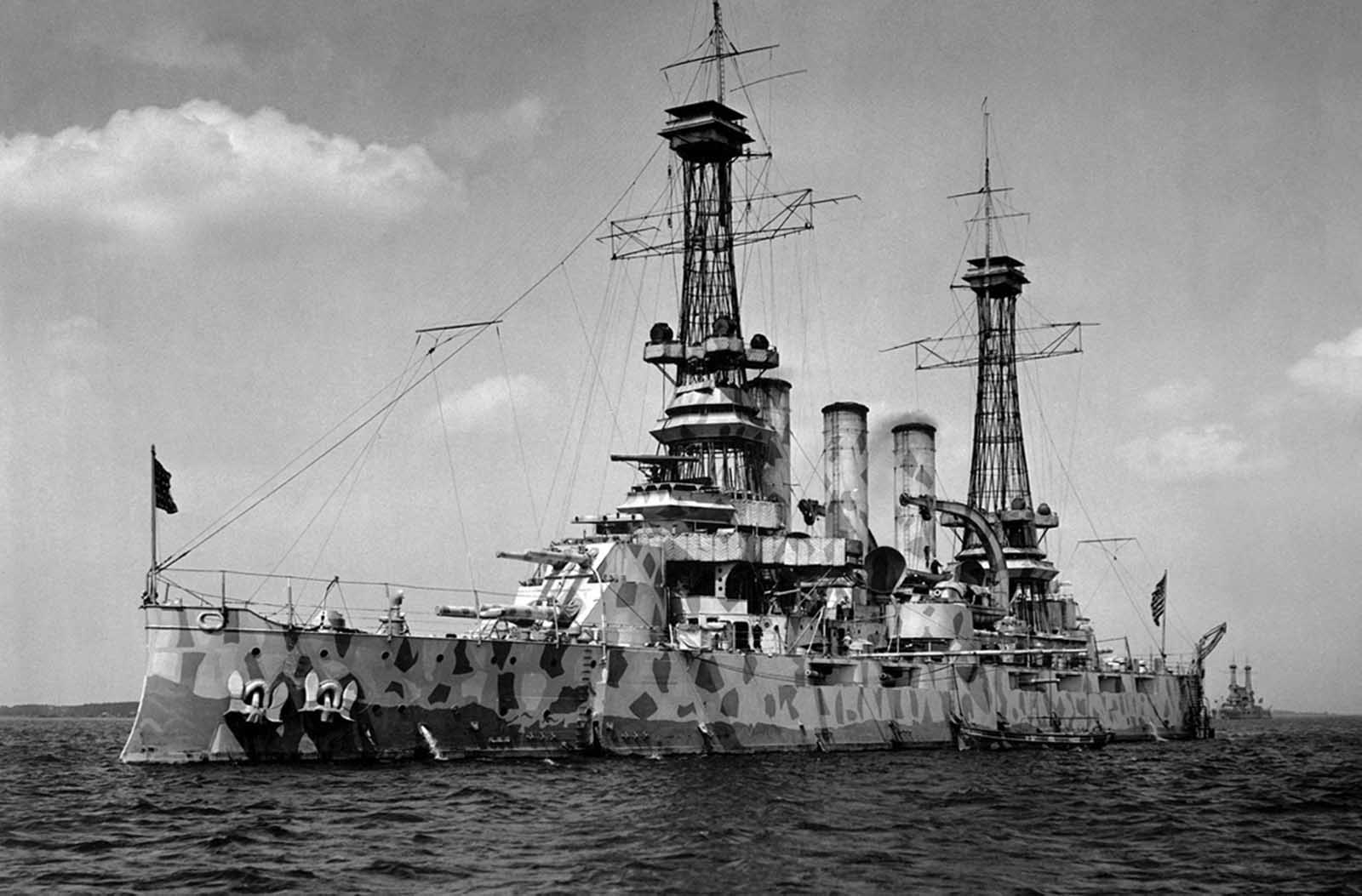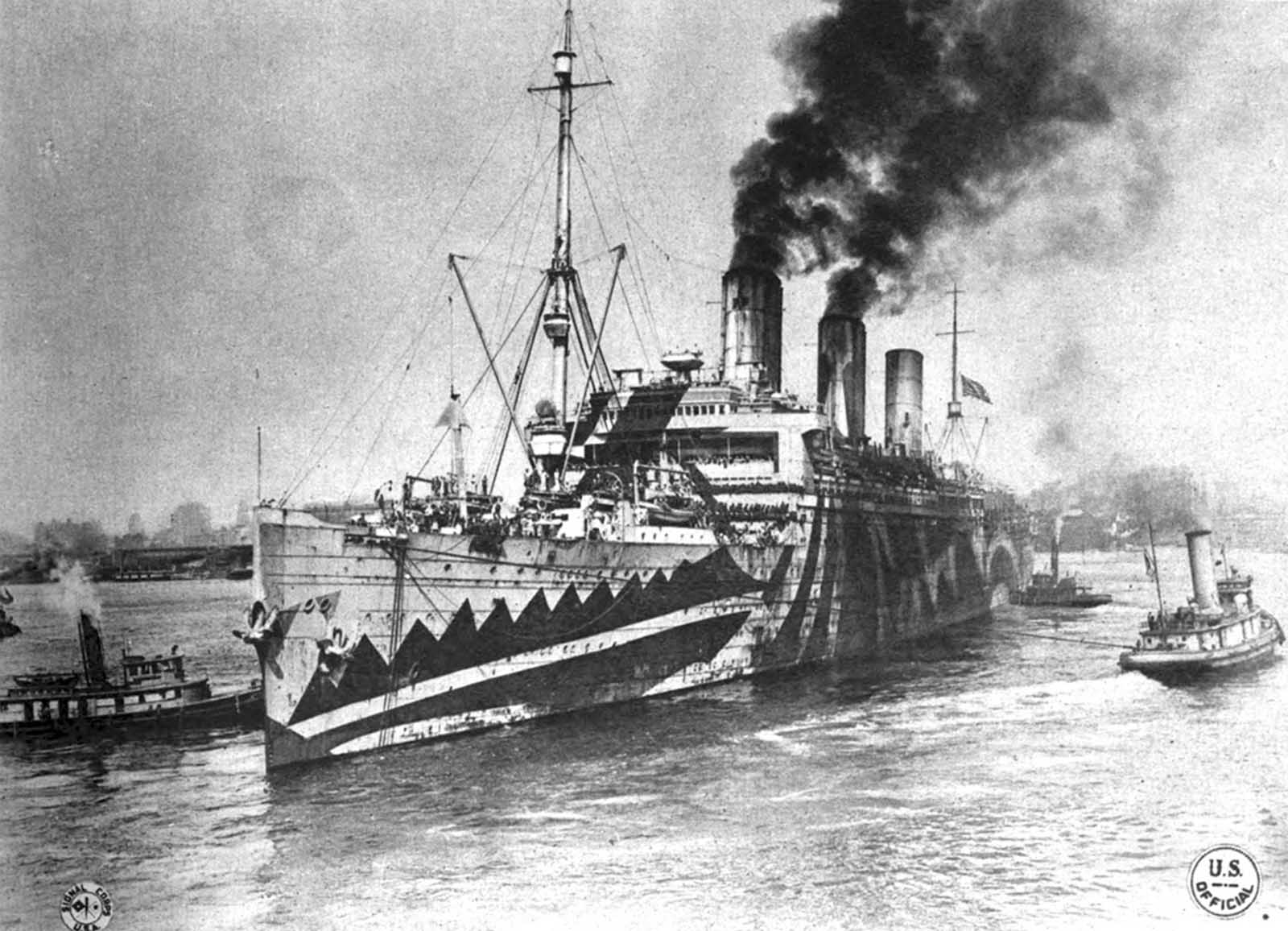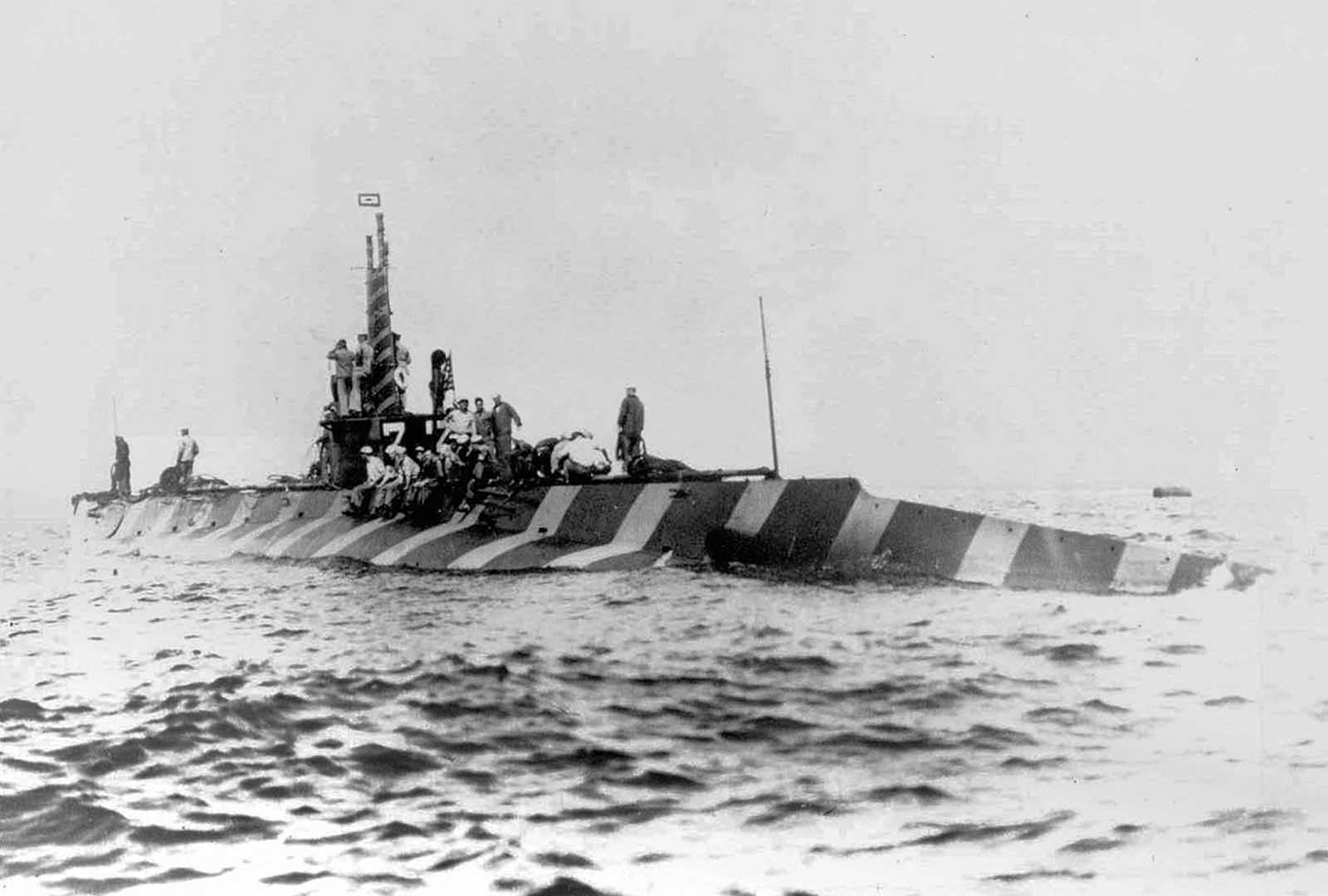A new generation of ships became central to the naval race: the dreadnoughts. Named after the Royal Navy’s HMS Dreadnought, these ‘castles of steel’ came to symbolise naval power in the early 20th century. The dreadnoughts represented a revolution in warship design and yet their construction was based on the centuries-old definition of the purpose of naval campaigning as being the head-on confrontation of two opposing battle fleets. During the First World War, not only did senior naval officers trained in the days of sail learn to command brand new ships and weaponry untested in wartime; they also witnessed a transformation in warfare that turned the war at sea from a traditional surface encounter into a complex balancing act of defensive strategies and covert tactics involving two new and unforeseen dimensions: under water and in the air. Britain was quick to capitalise on its enduring naval supremacy and geographical position by establishing a trade blockade of Germany and its allies as soon as war began. The Royal Navy’s Grand Fleet patrolled the North Sea, laid mines and cut off access to the Channel, curtailing the movements of the German High Seas Fleet and preventing merchant ships from supplying Germany with raw materials and food. The North Sea became ‘a marine no man’s land, with the British Fleet bottling up the exits’, as Richard Hough describes it in The Great War at Sea 1914-1918. The effect of the blockade on Germany’s civilians after four years of war was noted by British Army MajorGeneral Sir Aylmer Gould Hunter-Weston in December 1918 during a visit to Germany: “the food situation is very serious indeed…The Germans are living entirely on their food capital now – they have eaten all their laying hens and are eating all their milch [sic] cows… [there is a] real scarcity”. The simultaneous torpedoing of HMS Aboukir, Hogue and Cressy by a single German submarine in September 1914 shocked the Royal Navy and forced the Admiralty to recognise the threat that the U-Boats, as they became known, posed to the surface fleet. Although the Allies had their own submarines, which were active in the Adriatic, the Baltic and the Dardanelles over the course of the war, defences against submarines were slow to be developed. The British Navy appealed both to its own personnel and to the wider public for ideas. Minefields, net barrages, depth charges and patrols were introduced but more often than not these defences could be evaded. U-Boats could roam virtually undetected, since the sighting of a periscope was the most reliable method of location at a time when sonar technology was still in its infancy. In January 1916, in reply to an enquiry from former Prime Minister and then First Lord of the Admiralty Arthur Balfour, Commander-in-Chief of The Grand Fleet John Rushworth Jellicoe stressed the importance of playing to the Navy’s main strength – its size – to retain control of the North Sea: “…as to a possible naval offensive… I have long arrived at the conclusion that it would be suicidal to divide our main fleet…”. For the first two years of the war, the Allies accordingly concentrated their naval efforts on a defensive strategy of protecting trade routes, developing anti-submarine devices, and maintaining the blockade rather than actively seeking direct confrontation. The defense was a vital strategy but it was also grueling, repetitive, and unglamorous. Many in the navy longed for decisive action and a great naval victory to recall the Battle of Trafalgar and gratify the general public. The minor battles of the Heligoland Bight and Dogger Bank and the disastrous Dardanelles campaign did little to ease the tension. First Sea Lord Admiral H B Jackson commented to Jellicoe “I fancy you must look out for staleness [sic] with your important commanders, just as much as general health. I do wish you could get a change in your monotonous work”. Jackson’s wish was granted on 31 May-1 June 1916 when The Grand Fleet finally met the High Seas Fleet in direct combat off the coast of Denmark. The Battle of Jutland was to be the only major naval battle of the First World War, and the most significant encounter between warships of the dreadnought era. With fewer ships, Germany’s plan was to divide and conquer. A German advance force led by Vice-Admiral Franz Hipper engaged Vice-Admiral David Beatty’s battlecruisers, hoping to cut them off from the main fleet. A firefight ensued as Beatty chased Hipper, Hipper leading Beatty towards the rest of the High Seas Fleet. The Allies suffered early casualties in the loss of HMS Indefatigable and Queen Mary before Beatty turned to re-join the Grand Fleet. The High Seas Fleet and the Grand Fleet clashed throughout the afternoon until darkness descended. During the night the High Seas Fleet made its escape and by the early hours of 1 June, the battle was over. Both sides claimed the battle as a victory. Germany had inflicted greater losses on the Allies than it had suffered itself and yet the High Seas Fleet was incapacitated while the Grand Fleet remained the dominant naval factor. However, controversy over Jellicoe’s and Beatty’s actions quickly followed the battle and deprived both the Royal Navy and the British public of the outright triumph that years of frustration had called for. It is telling that Jellicoe’s parting words to his navy colleagues on leaving the Grand Fleet a few months later read ‘may your arduous work be crowned with a glorious victory’. After the Battle of Jutland the High Seas Fleet never again attempted to engage the entire Grand Fleet, and German naval strategy refocused on covert underwater operations. Submarine historian Richard Compton-Hall suggests that the starvation of the German population due to the Allied blockade had a decisive influence on U-Boat crews’ increasingly ruthless attacks, culminating in the declaration of unrestricted submarine warfare on 1 February 1917. U-Boats attacked merchant vessels, hoping to disrupt Allied trade and similarly weaken Britain, an island nation dependent on its imports. The result was huge loss of life in the Merchant Navy and a shortage of British shipping with which shipbuilders could not keep pace. Neutral ships were not immune and neither were passenger liners. RMS Lusitania had been sunk by a U-Boat in 1915, killing American passengers and prompting some to call for US entry into the war. The renewed threat to civilians caused the USA to declare war in April 1917, a month in which 869,000 tons of Allied shipping was sunk. A letter from the Board of Trade to the Cabinet in April 1916 had predicted that “…the shortage of shipping will place this country in more serious peril than can any calamity short of the defeat of the Navy…”. With The Grand Fleet undefeated it became clear that the war would be won or lost not in a traditional sea battle but by the Allies’ response to the so-called ‘submarine menace’. The Allied response was a system of convoys. Warships escorted merchant and passenger vessels, protecting them from U-Boat attack by virtue of strength in numbers. The concentration of shipping into small clusters in vast seas made ships harder rather than easier to find; evasive zigzag courses made it difficult for U-Boats to predict convoy routes and target torpedoes; and the accompanying warships were able to counter-attack using depth charges. The Royal Naval Air Service (RNAS) and later the US Naval Air Service provided cover, spotting submerged U-boats and thereby deterring them from surfacing and accurately targeting the convoy. Shipping losses dropped and by the time of the Armistice in 1918, the loss rate in the convoys was less than 0.5 percent. The war at sea was not characterized by monumental battles, glorious victories, and haunting landscapes as was the war on land. The Battle of Jutland was the only full-scale direct action to occur between opposing navies and even this was indecisive. Yet the blockade of supplies to Germany weakened the country, directly contributing to the end of the war, as indeed the U-Boat campaign would have done in reverse had the convoy system not eventually succeeded in saving Britain from starvation. Control of the North Sea meant no less than the difference between independence and invasion. The war at sea was a test of nerves and ingenuity. Both sides had to master technologies and ways of fighting unimaginable just a few years earlier. It was a marathon of endurance and persistence, often thankless but always critically important. (Photo credit: U.S. National Archives / Library of Congress / Deutsches Bundesarchiv. Text: Louise Bruton). Notify me of new posts by email.
Δ Subscribe












































